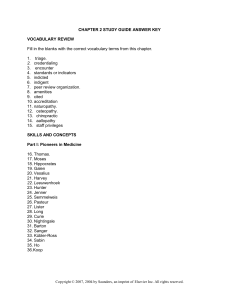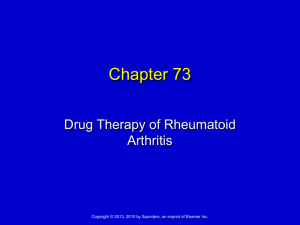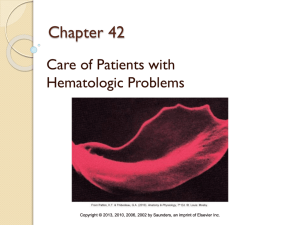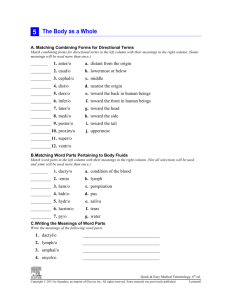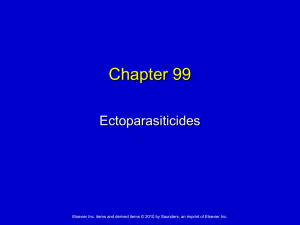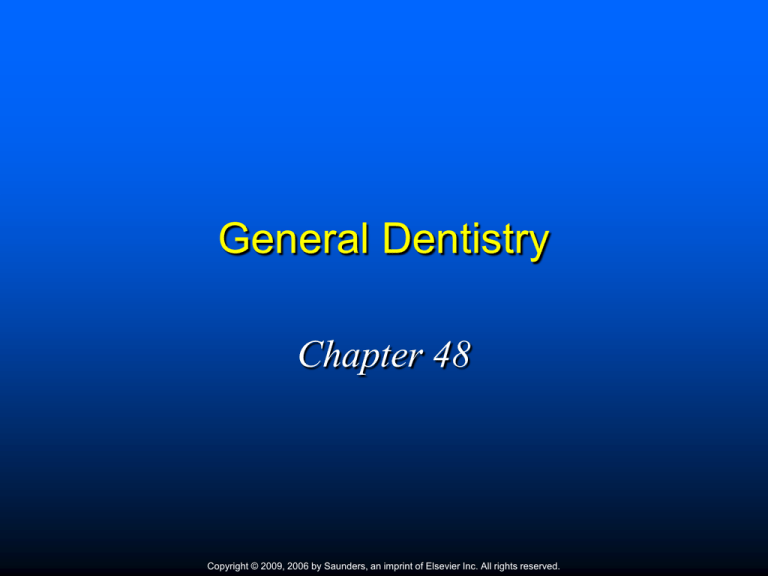
General Dentistry
Chapter 48
Copyright © 2009, 2006 by Saunders, an imprint of Elsevier Inc. All rights reserved.
Chapter 48
Lesson 48.1
Copyright © 2009, 2006 by Saunders, an imprint of Elsevier Inc. All rights reserved.
Learning Objectives
Define, spell, and pronounce the Key Terms.
Describe the process and principles of cavity
preparation.
Discuss the differences between assisting
with an amalgam and with a composite
restoration.
Copyright © 2009, 2006 by Saunders, an imprint of Elsevier Inc. All rights reserved.
Introduction
Restorative and aesthetic dentistry is
focused on the general dental
needs of the patient.
Copyright © 2009, 2006 by Saunders, an imprint of Elsevier Inc. All rights reserved.
Restorative Dentistry
Specific conditions that initiate a need for
restorative dental treatment are:
Initial or recurring decay.
Replacement of failed restorations.
Abrasion or the wearing away of tooth structure.
Erosion of tooth structure.
Copyright © 2009, 2006 by Saunders, an imprint of Elsevier Inc. All rights reserved.
Esthetic Dentistry
Specific conditions requiring aesthetic dental
treatment:
Discoloration due to extrinsic or intrinsic staining
Anomalies due to developmental disturbances
Abnormal spacing between teeth
Trauma
Copyright © 2009, 2006 by Saunders, an imprint of Elsevier Inc. All rights reserved.
Terminology in Cavity Preparation
Copyright © 2009, 2006 by Saunders, an imprint of Elsevier Inc. All rights reserved.
Initial Cavity Preparation
Outline form
Resistance form
Shape and placement of cavity walls
Retention form
Design and initial depth of sound tooth structure
To resist displacement or removal
Convenience form
Provides accessibility in preparing and restoring
the tooth
Copyright © 2009, 2006 by Saunders, an imprint of Elsevier Inc. All rights reserved.
Final Cavity Preparation
Removal of decayed dentin or old restorative
material
Insertion of resistance and retention with
the use of hand cutting instruments
and burs.
Placement of protective materials (liners,
bases, desensitizing, or bonding)
Copyright © 2009, 2006 by Saunders, an imprint of Elsevier Inc. All rights reserved.
Patient Preparation for
Restorative Procedures
Inform the patient what to expect throughout
the procedure.
Position the patient correctly for the dentist
and the type of procedure.
Explain each step to the patient as the
procedure progresses.
Copyright © 2009, 2006 by Saunders, an imprint of Elsevier Inc. All rights reserved.
Responsibilities of the Chairside
Assistant
Prepare the setup for the procedures.
Know and anticipate the dentist’s needs.
Provide moisture control.
Transfer dental instruments and accessories.
Mix and transfer dental materials.
Maintain patient comfort.
Copyright © 2009, 2006 by Saunders, an imprint of Elsevier Inc. All rights reserved.
Steps in the Restorative Procedure
The dentist evaluates the tooth to be restored.
The dentist administers local anesthesia.
The assistant readies the chosen means of moisture
control.
The dentist prepares the tooth.
The dentist determines the type of dental materials.
The assistant mixes and transfers the
dental materials.
The dentist burnishes, carves, or finishes the dental
material.
The dentist checks the occlusion of
the restoration.
The dentist finishes and polishes the restoration.
Copyright © 2009, 2006 by Saunders, an imprint of Elsevier Inc. All rights reserved.
Class I Restorations
These restorations are used in class I lesions,
affecting the pits and fissures of the teeth.
The following surfaces are involved:
Occlusal pits and fissures of
premolars and molars
Buccal pits and fissures of
mandibular molars
Lingual pits and fissures of the maxillary molars
Lingual pits of maxillary incisors, most frequently
in the pit near
the cingulum
Copyright © 2009, 2006 by Saunders, an imprint of Elsevier Inc. All rights reserved.
Fig. 48-5 Class I restorations.
Copyright © 2009, 2006 by Saunders, an imprint of Elsevier Inc. All rights reserved.
Class II Restorations
A class II lesion is the extension of a class I
lesion into the proximal surfaces of premolars
and molars.
The following surfaces are involved:
Two-surface restoration of posterior teeth
Three-surface restoration of posterior teeth
Four-surface (or more) restoration of posterior
teeth
Copyright © 2009, 2006 by Saunders, an imprint of Elsevier Inc. All rights reserved.
Fig. 48-7 Class II restorations.
(From Baum L, et al: Textbook of operative dentistry, ed 3, Philadelphia, 1995, Saunders.)
Copyright © 2009, 2006 by Saunders, an imprint of Elsevier Inc. All rights reserved.
Class III and IV Restorations
Class III lesion
Affects the interproximal surface of incisors and
canines
Class IV lesion
Involves a larger surface area, including the incisal
edges and interproximal surface of incisors and
canines
Copyright © 2009, 2006 by Saunders, an imprint of Elsevier Inc. All rights reserved.
Fig. 48-9 Class III composite restoration.
Copyright © 2009, 2006 by Saunders, an imprint of Elsevier Inc. All rights reserved.
Fig. 48-10 Class IV composite restoration.
Copyright © 2009, 2006 by Saunders, an imprint of Elsevier Inc. All rights reserved.
Class V Restorations
Class V restoration
Classified as a smooth-surface restoration.
Decayed lesions occur at:
Gingival third of the facial or lingual surfaces of
any tooth
Root of a tooth, near the cementoenamel junction
Copyright © 2009, 2006 by Saunders, an imprint of Elsevier Inc. All rights reserved.
Fig. 48-13 A, Class V conventional tooth preparation. B,
Schematic representation illustrating tooth preparation.
(From Roberson T, et al: Textbook of operative dentistry, ed 4, Philadelphia, 2006, Elsevier.)
Copyright © 2009, 2006 by Saunders, an imprint of Elsevier Inc. All rights reserved.
Chapter 48
Lesson 48.2
Copyright © 2009, 2006 by Saunders, an imprint of Elsevier Inc. All rights reserved.
Learning Objectives
Discuss why retention pins would be selected
for a complex restorative procedure.
Describe the need for placement of an
intermediate restoration.
Describe the procedure of composite
veneers.
Describe tooth-whitening procedures and the
role of the dental assistant.
Copyright © 2009, 2006 by Saunders, an imprint of Elsevier Inc. All rights reserved.
Complex Restorations
Such restorations are required when decay
has extended beyond the normal size or
shape.
Retention pins
Decay has extended into the cusp of a tooth and
undermined the enamel and dentin.
General understanding when using retention pins:
One pin is placed for each missing cusp.
Copyright © 2009, 2006 by Saunders, an imprint of Elsevier Inc. All rights reserved.
Fig. 48-14 Retention (retentive) pins placed in tooth structure
to help retain and support a restoration.
Copyright © 2009, 2006 by Saunders, an imprint of Elsevier Inc. All rights reserved.
Intermediate Restorations
Restoration placed for a short term.
Primary factors for placement
Health of the tooth
A wait to receive a permanent restoration
Financial reasons
Copyright © 2009, 2006 by Saunders, an imprint of Elsevier Inc. All rights reserved.
Procedure 48-5 Placement of intermediate restorative material.
Copyright © 2009, 2006 by Saunders, an imprint of Elsevier Inc. All rights reserved.
Direct Bonded Veneers
Veneer
Thin layer of tooth-colored material, applied to the
facial surface of a prepared tooth
Used to improve the appearance of teeth that
are:
Abraded
Eroded
Discolored with intrinsic stains
Darkened after endodontic treatment
Copyright © 2009, 2006 by Saunders, an imprint of Elsevier Inc. All rights reserved.
Fig. 48-15 Veneers placed to reduce discoloration and cover stain.
(From Roberson T, et al: Sturdevant’s art and science of operative dentistry, ed 4, St Louis, 2002, Mosby.)
Copyright © 2009, 2006 by Saunders, an imprint of Elsevier Inc. All rights reserved.
Fig. 48-16 Veneers placed to close diastema.
(From Roberson T, et al: Sturdevant’s art and science of operative dentistry, ed 4, St Louis, 2002, Mosby.)
Copyright © 2009, 2006 by Saunders, an imprint of Elsevier Inc. All rights reserved.
Tooth Whitening
Known as vital bleaching, tooth whitening
is a noninvasive method of lightening
dark or discolored teeth.
Copyright © 2009, 2006 by Saunders, an imprint of Elsevier Inc. All rights reserved.
Indications for Using a Tooth
Whitener
Indications for Procedure
Extrinsic stains from foods, cigarette smoking,
coffee, or tea
Aged, discolored teeth
Intrinsic stains, such as mild tetracycline stains
and mild fluorosis
Copyright © 2009, 2006 by Saunders, an imprint of Elsevier Inc. All rights reserved.
Fig. 48-17 Before-and-after photos of
tooth whitening used for extrinsic stains.
Copyright © 2009, 2006 by Saunders, an imprint of Elsevier Inc. All rights reserved.
Fig. 48-18 Before-and-after photos
of tooth whitening used for intrinsic stains.
(From Roberson T, et al: Sturdevant’s art and science of operative dentistry, ed 4, St Louis, 2002, Mosby.)
Copyright © 2009, 2006 by Saunders, an imprint of Elsevier Inc. All rights reserved.
Whitening Products
Chemical makeup
Active ingredient
• Either carbamide peroxide or hydrogen peroxide
Gel base
• With one or a mixture of propylene glycol, glycerin, and
water
Thickener
• Carbopol
Copyright © 2009, 2006 by Saunders, an imprint of Elsevier Inc. All rights reserved.
At-Home Tooth-Whitening Procedure
Material is placed in a thermoplastic custom
tray that the patient wears
for a designated period.
With the 10% to 16% carbamide peroxide gels,
the wear schedule is 1 hour twice a day for the
first week and once a day for the second week.
The 20% to 22% mixture is used for 1 hour a day
for 2 weeks.
Hydrogen peroxide is used for 15 to 30 minutes,
two or three times a day, for 2 weeks.
Copyright © 2009, 2006 by Saunders, an imprint of Elsevier Inc. All rights reserved.
Tooth-Whitening Strips
Thin, flexible strips are coated with
an adhesive hydrogen peroxide whitening
gel.
Application
The patient peels off the backing like a Band-Aid
and presses the strip to the facial anterior teeth.
The remaining portion of the strip is folded onto
the lingual surface.
Copyright © 2009, 2006 by Saunders, an imprint of Elsevier Inc. All rights reserved.
Possible Complications to Tooth
Whitening
Thermal hypersensitivity
Patient may experience sensitivity to heat and
cold after removal of the tray and material. The
use of toothpaste for sensitive teeth is
recommended.
Tissue irritation
Gingival tissue exposed to excess gel as a result
of improper tray fit may become irritated. Tell the
patient not to overfill the tray with material and to
remove any excess after seating the tray.
Copyright © 2009, 2006 by Saunders, an imprint of Elsevier Inc. All rights reserved.
Dental Assistant’s Role in
Tooth-Whitening Procedure
Aid in recording the medical and dental
history.
Assist in making shade selection.
Take intraoral photographs before and after
whitening.
Take and pour up preliminary impressions for
the tray.
Fabricate and trim the tray.
Provide postoperative instructions.
Assist in weekly or biweekly clinical visits.
Copyright © 2009, 2006 by Saunders, an imprint of Elsevier Inc. All rights reserved.
Patient Instructions for
Tooth-Whitening Procedure
Brush and floss before tray placement.
Place equal amounts of gel in tray.
Seat tray.
Do not eat or drink when wearing the tray.
Wear tray for the recommended time.
If the patient experiences any problems,
discontinue use and discuss with the dentist.
Copyright © 2009, 2006 by Saunders, an imprint of Elsevier Inc. All rights reserved.





